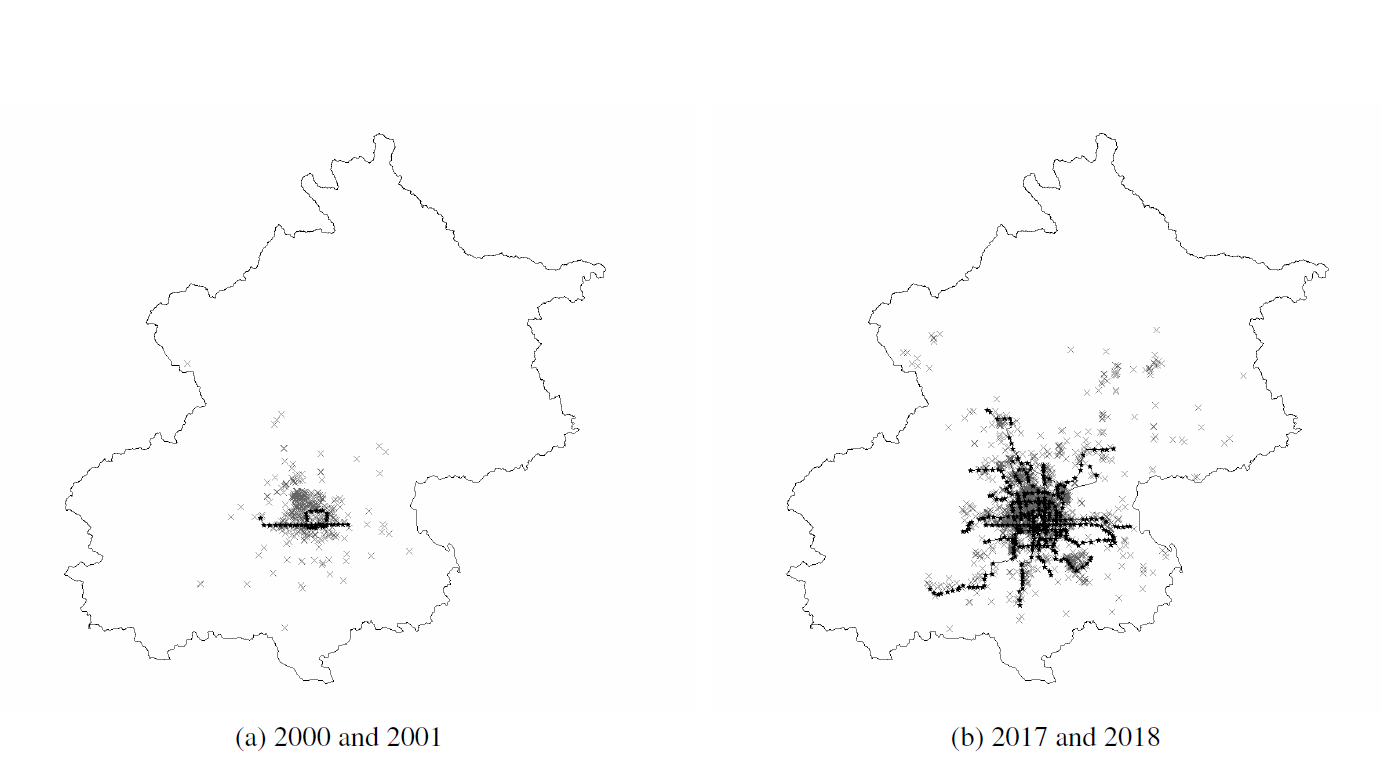
The expansion of the Beijing subway system is driving collaborative innovation by reducing travel costs and increasing matches among highly productive inventors
Constructing and maintaining subways is expensive. Just take a look at the Long Island Railroad project, which has racked up an eye-popping $3.5 billion price tag per mile of track (Zinkula and Boudreau 2023). But before dismissing the implementation of these pricey urban transit networks, policymakers must take into account the significant potential benefits of improved transport systems. Previous research shows that they can reduce traffic congestion and pollution (Gu et al. 2021, Gendron-Carrier et al. 2022), but the benefits of building subway lines go far beyond that. Our research (Koh, Li, and Xu 2022) focuses on the potential for improved intra-city transport infrastructure to facilitate collaborative innovation.
Expansion of subway network and improved connectivity
In our analysis (Koh, Li, and Xu 2022), we investigated the impact of subway build-up on the creative partnerships that lead to new and innovative patents. We focus on the explosive expansion of Beijing's subway system from 2000 to 2018; during this period the city's subway network grew from a modest 54 km to a sprawling 655 km, establishing it as one of the longest and busiest subway systems in the world. The impact of this transformation was felt far beyond the realm of transportation. For instance, Figure 1 displays the locations of collaborated patents and subway stations in lighter and darker grey marks, respectively, with the left (right) panel representing the years 2000-2001 (2017-2018). The figure shows that, as the subway system expanded to create an intricate web of underground train lines within Beijing, there was a remarkable surge in both the scale and geographical scope of patent collaborations following the layout of the expansion. The bottom line? In addition to its potential to improve transportation, the subway system may have far-reaching implications for the world of collaborative innovation.
Figure 1: Spatial distribution of collaborated patents and subway stations in Beijing

Collaborative innovation as a driver of growth and development
Why do we focus on collaborative innovation then? Innovation is the lifeblood of economic growth, and collaborative innovation has emerged as a critical driver of progress in the modern age. As knowledge and technology continue to advance and specialize, innovators with complementary expertise stand to gain tremendously from working together (Jones 2009). However, collaboration comes with its own set of costs, with travel costs being one of the biggest barriers to success. After all, when it comes to communicating tacit knowledge, nothing beats good old-fashioned face-to-face interaction (Battiston. Blanes i Vidal, and Kirchmaier 2021). That is why reducing travel costs can have a critical impact on the quality and quantity of collaborative innovation. By making it easier and more affordable for innovators to meet up and share their ideas, subway systems may expand the frontiers of innovation.
Identifying causal impact
However, isolating the true impact of subway expansions on collaborative innovation from other potentially confounding factors is not easy. The challenge lies in that the selection of locations for subway stations is often nonrandom. If stations are placed in areas that are predicted to become hubs of collaboration in the future, then any observed correlation between subway expansion and collaborative innovations could be simply attributed to central planning, rather than any real causal impact. This requires our methodology to carefully identify the mechanisms underlying any real cause-and-effect relationships. To achieve this, in our study, we implemented a rigorous approach that involved using patent collaborations as a proxy for collaborative innovation, and applying a variety of identification strategies (e.g. a discrete difference-in-differences specification, a continuous ``gravity-equation''-like specification; and a two-stage least squares specification by adopting an instrumental variable approach) to tease out the causal impact of subway expansion.
Results
Our main findings show that once a subway station opens, there is a steady increase in collaborated patents in the surrounding area – a 19.3% increase on average. As the travel time between locations reduces, the number of collaborated patents between those locations increases – an hour of reduced travel time leads to a 15% to 38% increase in collaborated patents, on average. Figure 2 includes two staggered difference-in-differences dynamic coefficient graphs, with the left panel showing the effects of a 30-minute reduction in travel time along the fastest route, and the right panel showing the effects of a 1-hour reduction. Both panels display the time-varying effects on collaborated patents in their IHS transformation, compared to control group consisting of location pairs that did not experience any subway station openings within the respective locations. The build-up and expansion of the subway system played a key role in the rising number of patent collaborations we observed, and we saw no evidence of pre-trends to suggest other alternative explanations.
Figure 2: Time-varying effects of improved connectivity on collaborated patents

Mechanism analysis
The baseline findings are just the beginning – there is so much more to uncover when it comes to the underlying mechanisms that drive the effect of subway expansions on patent collaborations. Thus, we delved deeper into the data and revealed four fascinating channels at work.
- Reduced travel costs make it easier for highly productive innovators to collaborate, leading to more pairs forming and more collaborations taking place among them.
- A reduction in travel time creates new opportunities for low-value matches between less productive innovators that would not have been formed otherwise.
- Locations that become more accessible attract more innovators, particularly those who are highly productive, to relocate and form collaborative matches.
- As the pool of active innovators expands to include potential innovators who were previously screened out, more collaborative matches are formed.
Of all these channels, we find that the first – increased matches among highly productive innovators – is the primary driver behind the significant impact of subway expansion on patent collaborations.
Back-of-the-envelope calculations
Our back-of-the-envelope calculations suggest a substantial economic impact of the increased collaborative patents resulting from subway expansion. Although there are some caveats, we estimate that the value of these patents is approximately 140 million to 195 million yuan, equivalent to around 20 million to 28 million US dollars in 2019. However, it is worth noting that these estimates only reflect contemporaneous effects and do not take into account any long-term dynamic responses. Given the constantly evolving nature of innovation, it is highly likely that the long-term economic implications of this increased collaboration will be significantly greater than what we calculated.
Policy implications
Our study suggests that policymakers aiming to promote innovation should consider designing subway routes that enhance connectivity between existing clusters of productive innovators. This is based on our study's finding that the most substantial increases in collaborative matches occur among highly productive innovators. As a result, such a strategy would have a greater and more immediate impact on innovations than connecting subway lines focused on fostering entry and matching among new innovators. In addition, our study shows that infrastructure investment aimed at specific geographic locations had varying effects on different subgroups of innovators. Consequently, an accurate evaluation of the overall composition of collaborative matches resulting from such investment could help to better design other complementary policies aimed at promoting innovation, such as tax incentives, R&D subsidies, and low-interest loans.
References
Battiston, D, J Blanes i Vidal, T Kirchmaier (2021), “Face-to-Face Communication in Organizations.” The Review of Economic Studies 88(2): 574–609.
Gendron-Carrier, N, M Gonzalez-Navarro, S Polloni, and M A Turner (2022), “Subways and urban air pollution.” American Economic Journal: Applied Economics 14(1): 164–196.
Gu, Y, J Zhang, and B Zou (2021), “Subways and road congestion.” American Economic Journal: Applied Economics 13(2): 83–115.
Koh, Y, J Li, and J Xu (2022), “Subway, Collaborative Matching, and Innovation.” The Review of Economics and Statistics 1-45. Available at: https://doi.org/10.1162/rest_a_01279.
Jones, B F (2009), “The burden of knowledge and the "Death of the Renaissance Man": Is innovation getting harder?” Review of Economic Studies 76: 283–317.
Zinkula, J, C Boudreau (2023, February 3) “It took 50 years and $11 billion to complete a train station beneath NYC's Grand Central Terminal. It shows how hard it is to build things in the US.” INSIDER. Available here.



